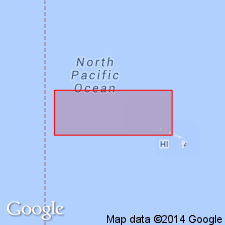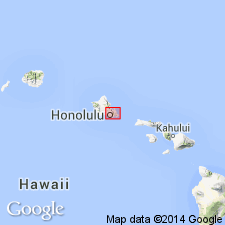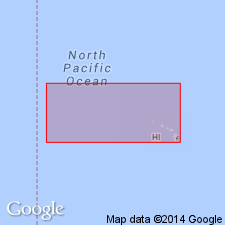
- Usage in publication:
-
- Mokolea basalt*
- Modifications:
-
- Named
- Dominant lithology:
-
- Basalt
- AAPG geologic province:
-
- Oahu
Summary:
Named for Mokolea Rock in Kailua Bay [Mokapu Point 7.5-min quadrangle] Island of Oahu. Included as unit in lower part of Honolulu volcanic series. Composed of nephelite-melilite basalt with olivine and pyroxene phenocrysts. Contains fossiliferous deposits indicating it is older than Waimanalo stand of sea. Tentatively assigned to Kaena stand of sea. Assigned middle(?) and late Pleistocene age.
Source: GNU records (USGS DDS-6; Menlo GNULEX).

- Usage in publication:
-
- Mokolea basalt*
- Modifications:
-
- Revised
- Age modified
- AAPG geologic province:
-
- Oahu
Summary:
Southern outcrop of Mokapu basalt (Stearns, IN Stearns and Vaksvik, 1935) is here considered part of Mokolea basalt due to lithological similarities and nearness of position across Kailua Bay. Tentatively assigned to Kahipa stand of sea.
Source: GNU records (USGS DDS-6; Menlo GNULEX).

- Usage in publication:
-
- Mokolea basalt*
- Modifications:
-
- Age modified
- AAPG geologic province:
-
- Oahu
Summary:
Exposed only in Mokolea Rock, small stack about 1 mi E of Mokapu Peninsula and 10 mi NW of Makapuu Head and possibly in small outcrop on Makapu Peninsula (see Mokapu basalt). No fossils. Fossiliferous deposits were found in crevices in it about 25 ft above sea level indicating it is older than plus 25-ft (Waimanalo) stand of sea. Assigned Pleistocene age.
Source: GNU records (USGS DDS-6; Menlo GNULEX).

- Usage in publication:
-
- Mokolea Basalt†
- Modifications:
-
- Abandoned
- AAPG geologic province:
-
- Oahu
Summary:
Mokolea Basalt (Stearns, IN Stearns and Vaksvik, 1935) and Mokapu Basalt (in part) abandoned as formally named units and called Mokolea flow, informal unit of Honolulu Volcanics.
Source: GNU records (USGS DDS-6; Menlo GNULEX).
For more information, please contact Nancy Stamm, Geologic Names Committee Secretary.
Asterisk (*) indicates published by U.S. Geological Survey authors.
"No current usage" (†) implies that a name has been abandoned or has fallen into disuse. Former usage and, if known, replacement name given in parentheses ( ).
Slash (/) indicates name conflicts with nomenclatural guidelines (CSN, 1933; ACSN, 1961, 1970; NACSN, 1983, 2005, 2021). May be explained within brackets ([ ]).

